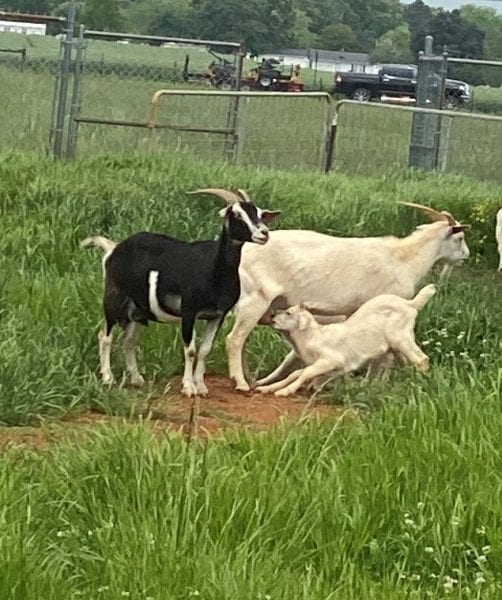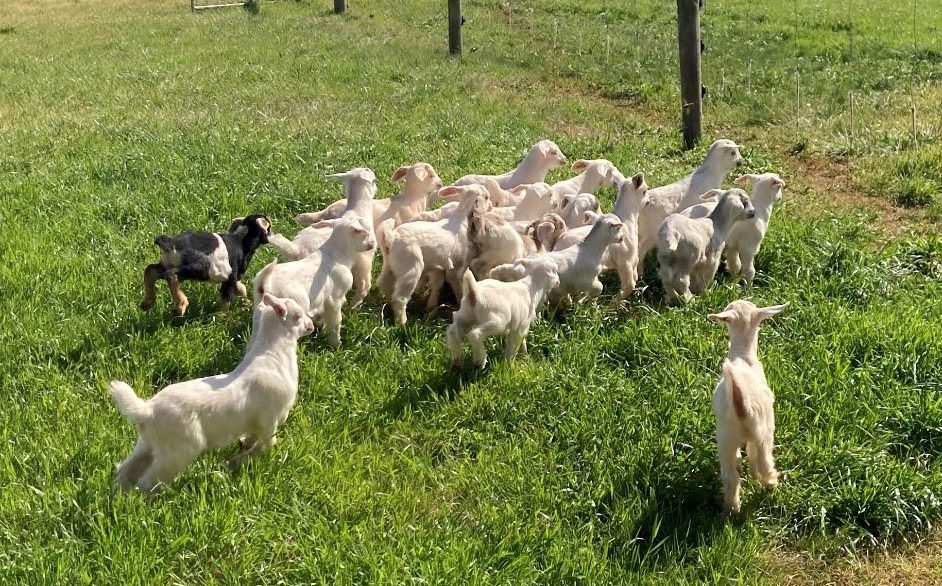Animals

Weaning is an important stage for herd or flock operations and should be carefully planned to prevent weaning stress. If not well planned, weaning can be a stressful process that makes animals more susceptible to diseases, thereby reducing animal growth and productivity.
When is the right time to wean?
 Following birth, the first three compartments of the stomach of a kid or a lamb (the rumen, reticulum, and omasum) are not fully developed and do not aid in the digestion of feed. During this period, a young kid or lamb will live off milk from the mother. Normally, the peak lactation for ewes or does is approximately four weeks after lambing, then milk production will decline. When milk production drops, the kid or lamb needs another feed source to get all the nutrients required for body maintenance and growth. High-quality forage, grains, a protein source, minerals, vitamins, and water should all be provided. At 4 months of age, the rumen of a goat or sheep is fully developed, which allows them to consume a wide variety of feed.
Following birth, the first three compartments of the stomach of a kid or a lamb (the rumen, reticulum, and omasum) are not fully developed and do not aid in the digestion of feed. During this period, a young kid or lamb will live off milk from the mother. Normally, the peak lactation for ewes or does is approximately four weeks after lambing, then milk production will decline. When milk production drops, the kid or lamb needs another feed source to get all the nutrients required for body maintenance and growth. High-quality forage, grains, a protein source, minerals, vitamins, and water should all be provided. At 4 months of age, the rumen of a goat or sheep is fully developed, which allows them to consume a wide variety of feed.
Why is weaning stressful for the animal?
After weaning, kids and lambs are separated from their mothers, which may cause emotional stress. Switching their diet can also cause digestive complications, especially when animals consume plants that contain toxic compounds. At the weaning stage, young sheep and goats have not developed a resistance to toxins yet. Weaned lambs and kids are also unfamiliar with defending themselves against predators. This may also cause more stress and make them more vulnerable.
Ways to Reduce Stressful Weaning
- Prevention of weaning stress starts during gestation. Pregnant ewes should receive adequate nutrients to produce healthy babies. During the first 12 hours after birth, kids and lambs must have access to colostrum (first milk) to enhance their immune systems.
- Lambs and kids must be vaccinated against certain diseases to boost their immune systems so they can fight stress during weaning.For example, kids and lambs should be vaccinated against enterotoxemia (overeating disease) at approximately 30 days of age with Clostridium CD Toxoid. They should receive a booster after two or three weeks and before weaning.
- Creep feeding can be an option prior to weaning. Creep feeding is the practice of providing supplemental feed to young nursing kids or lambs utilizing a creep gate. The creep gate must be large enough to allow young animals access to the supplemental feed but small enough to prevent the adults from getting into the feeder.
- A highly nutritious forage, such as red clover, alfalfa, or high-quality hay, should be ready before weaning.
- Kids and lambs should become familiar with a new pasture before separating them from their mothers.
- A good working facility is necessary to separate adults and young.
- Animals should be handled slowly and gently to minimize stress.
- One week prior to, and two days after weaning, ewes and does should be fed a high roughage diet, utilizing lower-quality forages to reduce milk production and prevent other diseases like mastitis (inflamed mammary tissue). Producers should avoid grain and protein supplements.
- When separating dams from offspring, weaned lambs/kids should remain on the existing pasture to reduce the stress of moving them around.
- Avoid performing other activities that add more stress to the animal, such as dehorning, docking, castration, hoof trimming, and vaccination, during the weaning stage.
- If planning to sell the weaned kids and lambs, market assessment (demand, location, and price) must be determined in advance. Producers should check state regulations about hauling animals and complete all other paperwork in advance.
- Before weaning, it is important to weigh animals and decide if any group of weaned kids or lambs needs more supplements or delayed weaning. The weaning weight should be adjusted based on age to decide if particular animals need to be culled or separated from the herd.
- If animals are weaned in an open pasture, the forage must be maintained at a taller grazing height to reduce parasite exposure.
Conclusion
Weaning should be planned in order to reduce negative impacts associated with weaning stress. Moreover, minimizing the negative impacts of weaning may result in lower overall farm input costs associated with the treatment of disease and less impact on animal weight and overall health. Visit the Alabama Extension website for additional information about sheep and goat management.

